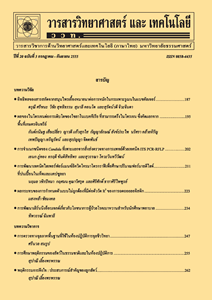การผลิตไบโอดีเซลด้วยกระบวนให้ความร้อนจากไมโครเวฟและการไหลต่อเนื่องและการทดสอบสมรรถนะของไบโอดีเซลในเครื่องยนต์ดีเซลสูบเดียว
Main Article Content
Abstract
บทคัดย่อ
เครื่องปฏิกรณ์สำหรับผลิตไบโอดีเซลแบบต่อเนื่องโดยอาศัยการให้ความร้อนจากคลื่นไมโครเวฟ ขนาด 2,000 W กำลังการผลิตสูงสุด 760 mL/min สร้างขึ้นสำหรับผลิตไบโอดีเซลจากน้ำมันปาล์มด้วยปฏิกิริยาทรานส์ เอสเทอริฟิเคชัน จากทดลองเพื่อหาสภาวะที่เหมาะสมหรับการผลิตพบว่าสารตั้งต้นที่อัตราส่วนโมลระหว่างแอลกอฮอล์ต่อน้ำมัน 7.5 : 1 ปริมาณตัวเร่งปฏิกิริยา KOH 2.0 % wt/wt อัตราการไหล 700 mL/min ทำปฏิกิริยาที่อุณหภูมิ 50 oC จะได้ไบโอดีเซลที่มีค่า FAMEs สูงสุด 97.4 % wt/wt และมีสมบัติไบโอดีเซลพื้นฐาน เป็นไปตามมาตรฐานไบโอดีเซลประเทศไทยที่กำหนดไว้ สำหรับการทดสอบสมรรถนะของไบโอดีเซลบนเครื่องยนต์ดีเซลทดสอบ ขนาด 10 แรงม้า ที่สัดส่วนไบโอดีเซลต่าง ๆ (B10 และ B50) เปรียบเทียบกับดีเซล (D100) นั้น พบว่าไบโอดีเซลที่ผลิตได้มีสมรรถนะการทำงานใกล้เคียงกับดีเซล โดยค่ากำลังเครื่องยนต์และแรงบิดสูงขึ้นเฉลี่ย 5.3 % และอัตราสิ้นเปลืองจำเพาะลงลดเฉลี่ย 3.7 % นอกจากนี้ไบโอดีเซลยังมีการปลดปล่อยมลพิษลดลงอีกด้วย
คำสำคัญ : ไมโครเวฟ; ไบโอดีเซล; การไหลต่อเนื่อง; น้ำมันปาล์ม; การทดสอบสมรรถนะ; เครื่องยนต์ดีเซล
Abstract
A continuous-flow microwave-assisted reactor, which has the microwave power of 2,000 W and maximum flow rate of 760 mL/min, was developed for biodiesel production from palm oil via transesterification. The experiments were conducted to determine the optimum conditions for biodiesel synthesis using the developed reactor. It is found that the maximum yield (FAMEs) of 97.4 % wt/wt was obtained at optimum conditions of 7.5 : 1 alcohol to oil molar ratio, 2.0 % wt/wt KOH, 50 oC reaction temperature and 700 mL/min flowrate. Biodiesel produced meets Thailand biodiesel standard. In addition, biodiesel blends (B10 and B50) were tested on a 10 HP diesel engine and compared with conventional diesel (D100). The result shows that the performance of biodiesel blends were similar to that of conventional diesel. The average power and torque of biodiesel blends were 5.3 % higher. The average specific fuel consumption of biodiesel blends was 3.7 % lower. Besides, biodiesel blends produced lower level emissions.
Keywords: microwave; biodiesel; continuous flow; palm oil; performance evaluation, diesel engine


